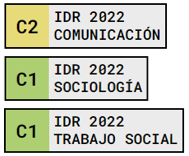Potencia, capacidad funcional y fuerza en mujeres sanas mayores: retos y perspectivas en el seno de una sociedad demográficamente envejecida
Palabras clave:
Potencia, Fuerza, Entrenamiento, Envejecimiento, Demografía, estudios de género.Resumen
El número de mujeres adultas mayores en la población española ha aumentado notablemente en las últimas décadas y comprender las características y los efectos del ejercicio físico en este tipo de población es importante a la hora de desarrollar planes de prevención de discapacidades y de mantenimiento de la independencia en el seno de una sociedad cada vez más longeva. Esta intervención tiene como objetivo comprobar los efectos de un programa de entrenamiento de potencia a intensidad baja (<40% RM) en población femenina, mayor de 65 años y sana. La hipótesis inicial defiende que dicho entrenamiento mejorará la capacidad funcional y la fuerza de las mujeres analizadas. Para ello, se realizó una intervención en la cual la intensidad varió desde el 20% hasta el 40% de la repetición máxima a lo largo de 12 sesiones repartidas en 6 semanas. Las variables observadas fueron la composición corporal, la capacidad funcional a través de diferentes pruebas y la fuerza máxima mediante una estimación del 1RM indirecto. Los resultados obtenidos muestran una mejora significativa en la composición corporal a consecuencia de una disminución del tejido graso, y una mejora en la capacidad funcional y la fuerza en el tren inferior.
Descargas
Citas
Abellán García, A., Ayala García, A. & Pujol Rodríguez, R. (14 de febrero, 2017) El estado de la población mayor en España, 2017 [Mensaje en un blog]. Recuperado de http://envejecimientoenred.es/el-estado-de-la-poblacion-mayor-en-espana-2017/
Aguado, A., Rodríguez, D., Flor, F., Sicras, A., Ruiz, A. & Prados-Torres, A. (2012). Distribución del gasto sanitario en atención primaria según edad y sexo: un análisis retrospectivo. Atención Primaria, 44(3) 145-152. doi: 10.1016/j.aprim.2011.01.011
Banco Mundial. (2015). Estimaciones del Banco Mundial usando la razón de las Perspectivas de población de la Organización de Naciones Unidas y del Banco Mundial. Recuperado de https://datos.bancomundial.org/indicator/SP.POP.65UP.FE.IN?locations=ES&view=chart
Bouchonville, M. F. & Villareal, D. T. (2013). Sarcopenic Obesity – How Do We Treat It?. Current Opinion in Endocrinology Diabetes and Obesity Journal, 20(5), 412-219. doi: 10.1097/01.med.0000433071.11466.7f.
Brzycki, M. (1993). Strength testing: predicting a one-rep max from reps-to-fatigue. Journal of Physical Education, Recreation and Dance, 64, 88-90. doi: 10.1080/07303084.1993.10606684
Cadore, E. L., Pinto, R. S., Bottaro, M., & Izquierdo, M. (2014). Strength and Endurance Training Prescription in Healthy and Frail Elderly. Review. Aging and Disease, 5(3), 183-195. doi: 10.14336/AD.2014.0500183
Cannon, J., Kay, D., Tarpenning, K. M. & Marino, F. E. (2007). Comparative effects of resistance training on peak isometric torque, muscle hypertrophy, voluntary activation and surface EMG between young and elderly women. Clinical Physiology and Functional Imaging, 27, 91-100. doi: 10.1111/j.1475-097X.2007.00719.x
Correa, C. S., Laroche, D. P., Cadore, E. L., Reischak-Oliveira, A., Bottaro, M., Kruel, L. F. & Pinto, R. S. (2012). 3 types of strength training in older women. International Journal of Sports Medicine, 33, 962-969. doi: 10.1055/s-0032-1312648
Davies, C. T., Dooley, P., Mcdonagh, M. N. & White, M. J. (1985). Adaptation to mechanical properties of muscle to high force training in man. Journal of Physiology, 365, 277-284. doi: 10.1055/s-0032-1312648
Ferrari, R., Kruel, L. F., Cadore, E. L., Alberton, C. L., Izquierdo, M., Conceição, M., Pinto, R. S., Radaelli, R., Wilhelm, E., Bottaro, M., Ribeiro, J. P. & Umpierre, D. (2013). Efficiency of twice weekly concurrent training in trained elderly men. Experimental Gerontology Journal, 48, 1236-1242. doi: 10.1016/j.exger.2013.07.016
González-Badillo, J. J. & Ribas, J. (2002). Bases de la programación de la fuerza. Barcelona: Editorial Inde.
Goodpaster B. H., Park S. W., Harris T. B., Kritchevsky S. B., Nevitt M., Schwartz A. V., Simonsick E. M., Tylavsky F. A., Visser M. & Newman A. B. (2006). The loss of skeletal muscle strength, mass, and quality in older adults: the health, aging and body composition study. Journal of Gerontoly: Medical Science, 10, 1059–1064. doi: 10.1093/gerona/61.10.1059
Granacher, U., Muelhbauer, T., & Gruber, M. (2012). A qualitative review of balance and strength performance in healthy older adults: impact for testing and training. Journal of Aging Research, 2012, 1-17. doi: 10.1155/2012/708905
Guralnik J. M., Ferrucci L., Simonsick E. M., Salive M. E. & Wallace R. B. (1995). Lower-extremity function in persons over the age of 70 years as a predictor of subsequent disability. The New England Journal of Medicine, 332(9), 556-62. doi: 10.1056/NEJM199503023320902
Häkkinen, K. & Hakkinen, A. (1995). Neuromuscular adaptations during intensive strength training in middleaged and elderly males and females. Electromyography and Clinical Neurophysiology Journal, 35, 137–147. doi: 10.1016/0021-9290(93)90391-Q
Häkkinen, K., Kallinen, M., Linnamo, V., Pastinen, U. M., Newton, R. & Kraemer, W. (1996). Neuromuscular adaptations during bilateral versus unilateral strength training in middle-aged and elderly men and women. Acta Physiologica Scandinavica Journal, 158, 77–88. doi: 10.1046/j.1365-201X.1996.523293000.x
Hakkinen, K., Komi, P. & Kauhanen, H. (1987). Scientific Evaluation of Specific loading of the knee extensor muscles with Variable Resistance, Isokinetic and Barbell Exercises. Medicine and Sport Science, 26, 224-237. doi: 10.1159/000414719
Hakkinen, K., Komi, P. V. & Kauhanen, H. (1985). Effect of explosive type strength training on electromyography and force production characteristics of leg extensor muscles during concentric and various strech-shortening cycle exercise. Scandinavian Journal of Medicine and Science in Sports, 7 (2), 65-76
Häkkinen, K., Newton, R. U., Gordon, S. E., Mccornick, M., Volek, J. S. & Nindl, B. C. Gotshalk, L.A., Campbell, W. W., Evans, W. J., Häkkinen, A., Humphries B. J., Kraemer, W. J. (1998). Changes in muscle morphology, electromyographic activity and force production characteristics during progressive strength training in young and older men. The journals of gerontology, Series A, Biological sciences and medical sciences, 53 (B4), 15-423. doi: 10.1093/gerona/53A.6.B415
Houston, M., Froese, E., Valeriote, S. P. & Green, H. (1983), Muscle performance, morphology and metabolic capacity during strength training and detraining: A one leg model. European Journal of Applied Physiology, 51(1), 25-35. doi: 10.1007/BF00952534
Instituto Nacional De Estadística. (2008). Encuesta de Discapacidad, Autonomía Personal y Situaciones de Dependencia (EDAD). Recuperado de http://www.ine.es/dynt3/inebase/index.htm?type=pcaxis&path=/t15/p418/a2008/hogares/p01/modulo1&file=pcaxis
Instituto Nacional De Estadística. (2014). España en cifras. Recuperado de http://www.ine.es/prodyser/espa_cifras/2014/files/assets/basic-html/index.html#3/
Izquierdo, M., Häkkinen, K., Ibañez, J., Garrues, M., Antón, A., Zúniga, A., Larrión, J. L. & Gorostiaga, E. (2001). Effects of strength training on muscle power and serum hormones in middle-aged and older men. Journal of Applied Physiology, 90, 1497-1507. doi: 10.1152/jappl.2001.90.4.1497
Komi, P. V. (1986). Training of muscle strength and power: interaction of neuromotoric, apunts. Hypertrophic and mechanical factors. International Journal of Sports Medecine. (Suppl), 7, 10-15. doi: 10.1055/s-2008-1025796
Komi, P. V., Viitasalo, J. T., Rauramaa, R. & Vihko, V. (1978). Effect of isometric strength training on mechanical, electrical and metabolic aspects of muscle function. European Journal of Applied Physiology, 40, 45-55. doi: 10.1007/BF00420988
Maughan, R. J., Watson, J. S. & Weir, J. (1983). Strength and cross-sectional area of human skeletal muscle. Journal of Physiology, 338, 37-49. doi: 10.1113/jphysiol.1983.sp014658
Millor, N., Lecumberri, P., Gómez, M., Martínez-Ramírez, A., & Izquierdo, M. (2013). An evaluation of the 30-s chair stand test in older adults: frailty detection based on kinematic parameters from a single inertial unit. Journal of NeuroEngineering and Rehabilitation, 10, 86. doi: 10.1186/1743-0003-10-86.
Narici, M. V., Roi, G. S., Landoni, L., Minetti, A. E. & Cerretelli, P. (1989). Changes in force, cross-sectional area and neural activation during strength training and detraining of the human quadriceps. European Journal of Applied Physiology, 59(4), 310-319. doi: 10.1007/BF02388334
Organización Mundial de la Salud. (2002). Active ageing: a policy framework. Geneve: WHO.
Organización Mundial de la Salud. (2002). Envejecimiento activo: un marco político. Revista Española en Geriatría y Gerontología;37: 74–105.
Pereira, A., Izquierdo, M., Silva, A. J., Costa, A. M., Gonzalez-Badillo, J. J. & Marques, M. C. (2012). Muscle performance and functional capacity retention in older women after high-speed power training cessation. Experimental Gerontology, 47, 620–624. doi: 10.1016/j.exger.2012.05.014
Pinto, R. S., Correa, C. S., Radaelli, R., Cadore, E. L., Brown, L. E. & Bottaro, M. (2013). Short-term strength training improves muscle quality and functional capacity of elderly women. Age (Dordr), 36(1):365-72. doi: 10.1007/s11357-013-9567-2
Radaelli, R., Botton, C. E., Wilhelm, E. N., Bottaro, M., Lacerda, F., Gaya, A., Moraes, K., Peruzzolo, A., Brown, L. E. & Pinto, R. S. (2013). Low- and high-volume strength training induces similar neuromuscular improvements in muscle quality in elderly women. Experimental Gerontology Journal, 48 (8), 710-716. doi: 10.1016/j.exger.2013.04.003
Reid, K. F., Callahan, D. M., Carabello, R. J., Philips, E. M., Frontera, W. R., & Fielding, R. A. (2008). Lower extremity power training in ederly subjects with mobility limitations: a randomized controlled trial. Aging Clinical and Experimental Research, 20(4), 337-343. doi: 10.1249/00005768-200605001-01432
Rikli, R. E., & Jones, C. J. (2001). Senior Fitness Test Manual. Champaign, IL: Human Kinetics.
Robine Jean Marie, Project Leader / Isabelle Beluche, Coordination of the Country reports. European Health & Life Expectancy –EHLEIS-, Health Expectancy in Spain 2015. European Health and Life Expectancy Information System (2015). Health Expectancy in Spain. Recuperado dehttp://www.eurohex.eu/pdf/CountryReports_Issue9/Spain_Issue9.pdf/
Ronnestad, B. R., Egeland W., Kvamme, N. H., Refsnes, P. E., Kadi, F. & Raastad, T. (2007). Dissimilar effects of one- and three-set strength training on strength and muscle mass gains in upper and lower body in untrained subjects. The Journal of Strength & Conditioning Research, 21(1), 157-63. doi: 10.1519/R-19895.1
Santilli, V., Bernetti, A., Mangone, M., & Paoloni, M. (2014). Clinical definition of sarcopenia. Clinical Cases in Mineral and Bone Metabolism, 11(3), 77-180. doi: 10.11138/ccmbm/2014.11.3.177
Sayers, S. P., Guralnik, J. M., Thombs, L. A. & Fielding, R. A. (2005). Effect of leg muscle contraction velocity on functional performance in older men and women. Journal of the American Geriatrics Society, 53(3), 467-71. doi: 10.1111/j.1532-5415.2005.53166.x
Soriano, M. A., Jiménez-Reyes, P., Rhea, M. R. Y Marín, P. J. (2015). The Optimal Load for Maximal Power Production During Lower-Body Resistance Exercises: A Meta-Analysis. Sports Medicine Journal, 45(8), 1191-205. doi: 10.1007/s40279-015-0341-8
Descargas
Publicado
Cómo citar
Número
Sección
Licencia
Los autores/as que publiquen en esta revista aceptan las siguientes condiciones:
- Los autores/as conservan los derechos de autor.
- Los autores/as ceden a la revista el derecho de la primera publicación. La revista también posee los derechos de edición.
- Todos los contenidos publicados se regulan mediante una Licencia Atribución/Reconocimiento-SinDerivados 4.0 Internacional. Acceda a la versión informativa y texto legal de la licencia. En virtud de ello, se permite a terceros utilizar lo publicado siempre que mencionen la autoría del trabajo y a la primera publicación en esta revista. Si transforma el material, no podrá distribuir el trabajo modificado.
- Los autores/as pueden realizar otros acuerdos contractuales independientes y adicionales para la distribución no exclusiva de la versión del artículo publicado en esta revista (p. ej., incluirlo en un repositorio institucional o publicarlo en un libro) siempre que indiquen claramente que el trabajo se publicó por primera vez en esta revista.
- Se permite y recomienda a los autores/as a publicar su trabajo en Internet (por ejemplo en páginas institucionales o personales), una vez publicado en la revista y citando a la misma ya que puede conducir a intercambios productivos y a una mayor y más rápida difusión del trabajo publicado (vea The Effect of Open Access).


















